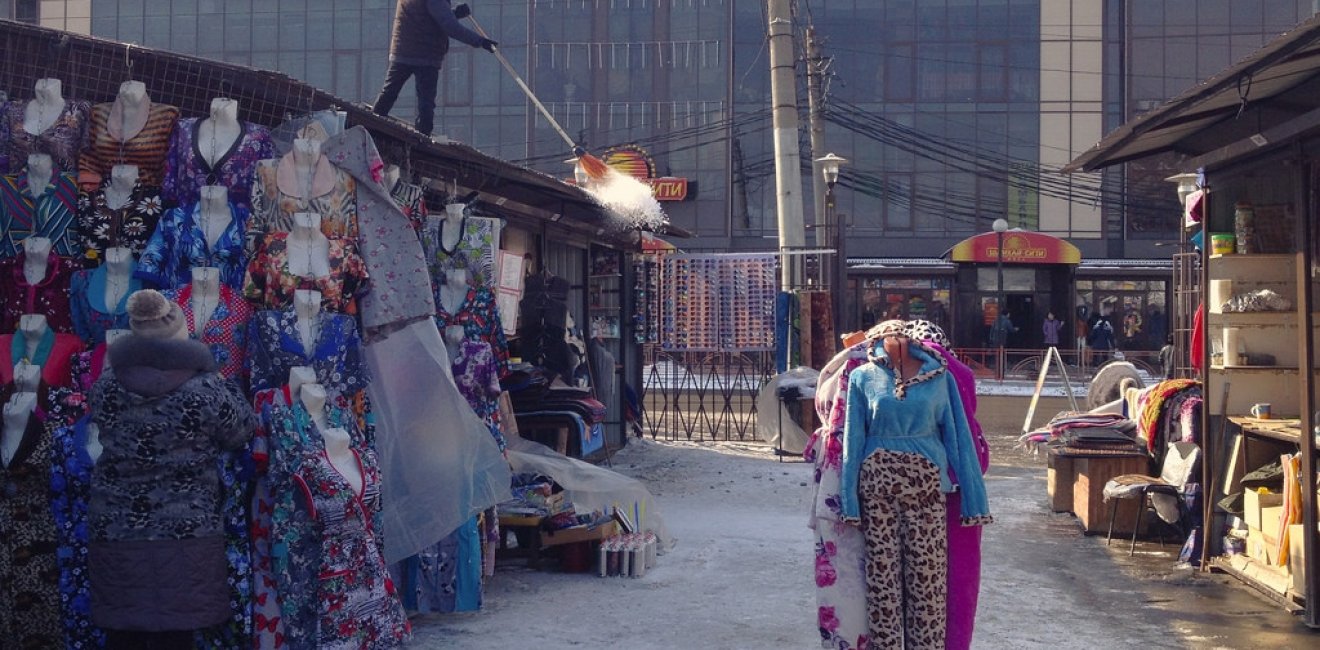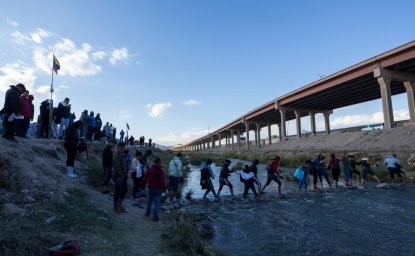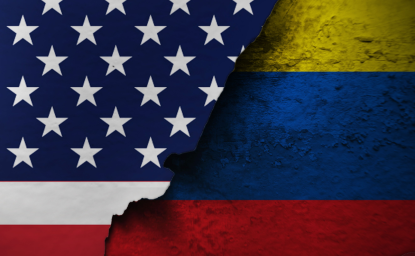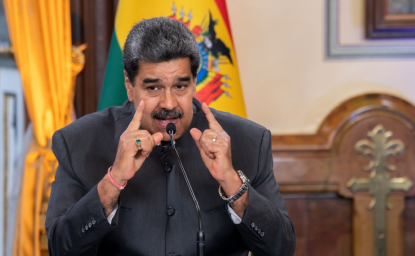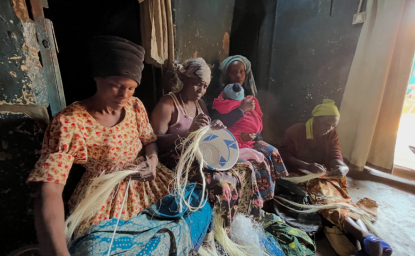Anzur moved to Irkutsk, a city in Siberia near Lake Baikal, from his home in Uzbekistan on the advice of his brother, who had lived there previously. After a serious injury ended his hopes of becoming a professional soccer player, the 19-year-old Anzur had few options for earning money. When I met him, he had been in Irkutsk for a year and a half and was working as a custodian in an office building.
“I just wanted to make some money,” said Anzur when I asked why he left home. Life was good in Irkutsk, he told me, but he planned to move back to Uzbekistan before the next winter. I could see his point. We met in the spring, but the temperatures were still frigid.
Anzur is one of approximately 2 million migrants from Central Asia who are currently in Russia because of the work opportunities to be found there. Like many Russian cities, Irkutsk receives a large number of migrant workers from Central Asia and, because of its location, it attracts many Chinese migrants as well. Migrants there tend to work in custodial jobs, construction, and retail.
In March 2014 I visited the country as part of a United States–Russia working group sponsored by the Eurasia Foundation to learn more about immigration patterns in Russia. Anzur’s story was typical of many that I heard from migrants, migration and legal experts, and representatives of nongovernmental organizations: many migrants come to Russia, but they don’t plan to stay.
Since the Soviet Union dissolved in 1991, a steady stream of migrants have made their way to Russia in different waves over the years. In the early 1990s, ethnic Armenians, Azerbaijanis, Tajiks, Uzbeks, and Russians alike fled to Russia due to ethnic violence, instability, and civil war in many parts of the former Soviet Union. The early post-Soviet flows were largely refugees, and largely ethnic Russians returning to Russia.
Beginning in the 2000s, the majority of migrants were coming for socioeconomic reasons, and there were fewer and fewer ethnic Russians—most of whom had repatriated in the 1990s—among them. Instead, non–ethnic Russian migrants were coming from the former republics, in particular from Ukraine and Moldova, and there were also growing numbers of labor migrants from China, Turkey, and Vietnam.
In 2007, considerably more migrants started coming from Central Asia (often Uzbekistan, Tajikistan, and Kyrgyzstan) due to new migration laws that allowed citizens of these countries to easily obtain work permits. This trend continues today, as the majority of migrants in Russia are from Central Asia; a considerable number are from Ukraine, Armenia, Moldova, Azerbaijan, and Georgia as well. Migrants continue to arrive from China, Vietnam, the Middle East, and Africa. Russia is now second only to the United States in the number of foreign-born residents, according to United Nations estimates.
In the wake of the dissolution of the Soviet Union, regulation of movement across the newly international borders was slow to develop. Ultimately, new citizenship and migration policies were established in the successor states. The Russian government began a long process of clarifying its migration policy starting in the mid-1990s, and its “Concept of the National Migration Policy in the Russian Federation” has since been redrawn several times, reacting to both global events (9/11, the 2008 economic crisis) and domestic politics (Vladimir Putin’s return to the presidency in 2012). The current “Concept” is in effect until 2020, and while it too has been criticized by Russian migration experts, it did bring more consistency to migration legislation, which had been an unwieldy string of acts that were ratified quickly and disjointedly, and often contradicted each other.
One of the most important aspects of Russia’s newest “Concept of Migration” is that it recognizes the need for foreign labor for sustainable growth of the country and openly acknowledges the government’s failure to facilitate integration and adaptation of migrants. It does not, however, provide a road map of how it plans to assist migrants in the future. Over the past few decades, Russia has had to contend with high mortality and low birth rates, which have weakened its workforce. Russia desperately needs immigrants in order to grow its labor force, but, although this fact is well known, the country has yet to define a strategy for attracting immigrants to come to Russia and stay, nor for encouraging integration by working with both migrants and local populations.
A large number of immigrants come from poorer countries and are willing to work for very low wages, much less than what a Russian citizen would be paid for the same work, causing resentment among many Russians. It is also common to hear complaints about several migrants or migrant families sharing an apartment, while only the approved number of residents are officially registered. Simultaneously, fake registration companies take money from migrants to provide them with “official registration” (a residency permit required for everyone in Russia) for homes where they’ve never set foot. Sometimes hundreds of migrants are “officially” registered at one address. Migrants who buy fake registrations may be prosecuted rather than the companies who sell them, depending on which route the government finds most expedient.
New Russian government policies for obtaining work permits have led to more corruption by officials who extort money from both migrants and the Russians who want to hire them. Widespread corruption and inconsistent application of laws make conditions for migrants precarious and, in turn, feed local residents’ anti-immigrant sentiments, as they see growing numbers of migrants take jobs in their town and crowd into their apartment buildings or live in trailers outside them. At the mildest, such attitudes can be seen in apartment ads specifying “ethnic Russians only” and at worst, violent anti-migrant riots sparked by a variety of interethnic clashes have cropped up across the country.
What goes on between the time a migrant arrives in Russia and the time he or she returns home? What influences a migrant’s decision about how long to stay? What do Russians think of the migrants, and do their attitudes vary depending on region? In search of answers, I traveled to Irkutsk, Perm, and Moscow. In each city, I spoke to migrants, journalists, businesspeople, government officials, and researchers.
Because of its remote location in Siberia, the city of Irkutsk is dependent on migrants to sustain its labor force. Scenes from Irkutsk (from top): a shuttle driver, a man leaves a bar at sunrise to head home, a street vendor pitches a dental heath product made from tree sap, a train stop in a small town just outside Irkutsk.
My first stop was in the Siberian city of Irkutsk, where I met with Alexander Gimel’shtein, the editor of Eastern Siberian Pravda, a local newspaper, to get his take on local-migrant relations. He said that “while not idyllic, the general attitude toward migrants could be described as neutral.”
Several people I met believe that Irkutsk’s remote location on Russia’s eastern frontier and its history of receiving in the 19th century political exiles from St. Petersburg and Chinese merchants makes its residents more tolerant of immigrants than the people of some other Russian cities. According to Gimel’shtein, the more likely explanation is that the city has far more pressing problems, such as corruption, housing, and environmental issues, that tend to overshadow concerns about migration. “Migrants aren’t taking locals’ jobs,” he said, “so people aren’t asking for migrants to leave. On the contrary, people are saying we need more foreign workers, largely for construction jobs.”
“Siberia was, is, and always will be dependent on migration” to sustain its labor force, a historian at Irkutsk State University told me.
Next, I traveled west to Perm, a city twice the size of Irkutsk that is located near the Ural Mountains, which run north to south and divide Russia between Europe and Asia. A closed city during the Soviet period, Perm was a major center for arms production. Today it boasts industries such as aviation, chemicals, and shipbuilding, and a vibrant arts scene. Like Irkutsk, it has average immigrant flows for an urban area in Russia, mostly labor migrants from Tajikistan, Uzbekistan, Kyrgyzstan, Azerbaijan, and, to a lesser extent, China. A resident told me that Perm needs migrants who know foreign languages and possess technology skills, but due to quotas set by Moscow, local officials have no authority to hire high-skilled immigrants. Many people told me that officials in Moscow are making immigration decisions that do not consider the needs of the various regions.
While some people I met believe that Perm is a calm and peaceful city, others are more wary. Andrei Suslov, director of the Center for Civic Education and Human Rights in Perm, told me about an incident a few months before my visit. Someone posted (incorrectly) on a popular social networking site that migrants had killed an ethnic Russian man and called on people to come out and avenge the murder. A large group of young men arrived at the named location and beat an immigrant badly before police arrived. “We have a myth that everything is good here in terms of interethnic relations, that no ethnic riots can happen here,” said Suslov. “But this incident shows us that real work needs to be done—through education, social initiatives, and so on. It is not enough to celebrate the national holidays of various groups and [recognize] their different traditions. We do that here and it might be good, but to think that this will help bring about mutual understanding? I seriously doubt it.”
Suslov was doing more than talk about the issues. While I was in Perm, I attended portions of a two-day workshop he organized for local teachers on incorporating civic responsibilities and human rights into their curricula. The teachers spoke frankly about the challenges associated with immigrant children in their classrooms and the lack of institutional support for those students. I witnessed a long debate about what tolerance means and how to shape behavior in the classroom. While there were no clear answers, a crucial dialogue had been started. I visited other human rights and civic engagement centers where similar discussions were taking place.
My last stop, as I moved west again, was Moscow, which has by far the most immigrants in the country. I interviewed researchers and former migration officials who said that migrants are often viewed as second-class citizens and that interethnic conflicts are expected to increase in the coming years as the economy continues to deteriorate and Russian nationalism continues to grow in connection with the crisis in Ukraine.
I had a long conversation about immigration with a taxi driver in Moscow. He told me: “Caucasians [people from the Caucasus] here are treated like blacks in the United States. Only, over there you can prosecute someone for discrimination. Here they don’t.”
While race relations in the United States are more nuanced than his statement suggests, his point about a lack of repercussions for Russians’ deep-seated prejudice seems accurate. The driver had moved to Moscow seven years before from Beslan, a town in North Ossetia. Although North Ossetia is in Russia’s Caucasus region and its residents are Russian citizens, the driver’s Caucasian appearance was enough to make him a victim of local prejudice.
“A few times, men have started fights with me, simply because I’m not [ethnically] Russian,” he said. “They wanted to kill me for this. . . . I can ignore the discrimination as long as they don’t get physical with me.”
The taxi driver’s experiences illustrate what historians and government officials in all three cities told me: much of the Russian population doesn’t distinguish between international migrants and Russia’s own ethnic minorities. Rather, migrants are lumped together in a vague group called foreigners. Xenophobia and racism are at the core of these attitudes, which are frequently stoked by the media as well as through nationalistic slogans employed by politicians at the national and local levels.
Russia faces a host of serious problems, most notably a severe economic downturn that resulted from its role in the Ukraine conflict. Many social issues are simmering below the surface. In each of the three cities I visited, migrants told me that they plan to be in Russia temporarily, preferring to go back to their often-poorer homes than stay where they are made to feel unwelcome and even sometimes physically attacked.
Yet given the country’s dire need for a more robust workforce, it would do well to enact policies and programs that entice immigrants not only to come to Russia, but also to stay. For this to happen, there needs to be trust on both sides: ethnic Russians welcoming migrants into their neighborhoods and workplaces, and migrants demonstrating a long-term commitment to and respect for their new home.
The opinions expressed in this article are those solely of the author.
This article was originally published in the Carleton College Voice.

